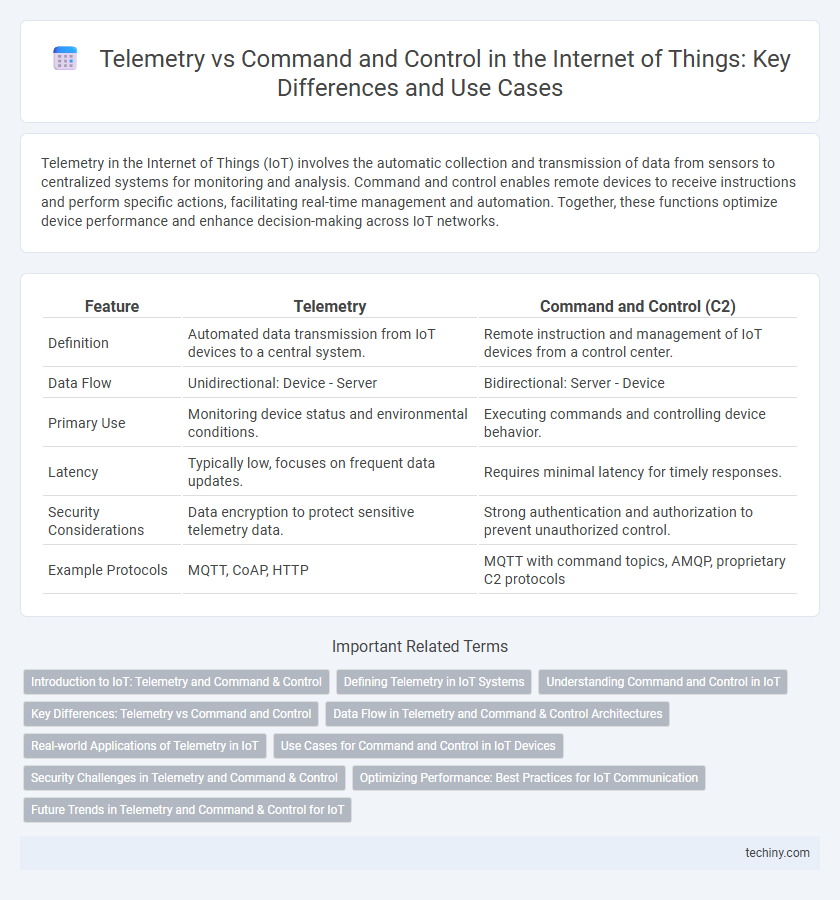Telemetry in the Internet of Things (IoT) involves the automatic collection and transmission of data from sensors to centralized systems for monitoring and analysis. Command and control enables remote devices to receive instructions and perform specific actions, facilitating real-time management and automation. Together, these functions optimize device performance and enhance decision-making across IoT networks.
Table of Comparison
| Feature | Telemetry | Command and Control (C2) |
|---|---|---|
| Definition | Automated data transmission from IoT devices to a central system. | Remote instruction and management of IoT devices from a control center. |
| Data Flow | Unidirectional: Device - Server | Bidirectional: Server - Device |
| Primary Use | Monitoring device status and environmental conditions. | Executing commands and controlling device behavior. |
| Latency | Typically low, focuses on frequent data updates. | Requires minimal latency for timely responses. |
| Security Considerations | Data encryption to protect sensitive telemetry data. | Strong authentication and authorization to prevent unauthorized control. |
| Example Protocols | MQTT, CoAP, HTTP | MQTT with command topics, AMQP, proprietary C2 protocols |
Introduction to IoT: Telemetry and Command & Control
Telemetry in IoT refers to the automated collection and transmission of data from connected devices to centralized systems for monitoring and analysis. Command and control involve sending instructions from a central platform to IoT devices to manage their operations and respond to conditions in real time. Understanding the distinction between these two communication types is essential for optimizing IoT system performance and ensuring seamless device interaction.
Defining Telemetry in IoT Systems
Telemetry in IoT systems refers to the automatic collection and transmission of sensor data from connected devices to centralized platforms for real-time monitoring and analysis. This process enables continuous observation of environmental conditions, device status, and performance metrics without manual intervention. Telemetry forms the foundation for data-driven insights, predictive maintenance, and efficient resource management in Internet of Things applications.
Understanding Command and Control in IoT
Command and control in IoT refers to the ability to send instructions from a central system to connected devices, enabling real-time management and automation of operations. This functionality allows for remote configuration, device monitoring, and execution of specific tasks based on predefined rules or dynamic conditions. Effective command and control systems enhance responsiveness, operational efficiency, and security within IoT ecosystems by maintaining seamless communication between controllers and edge devices.
Key Differences: Telemetry vs Command and Control
Telemetry in the Internet of Things (IoT) involves the automated collection and transmission of real-time data from devices to centralized systems for monitoring and analysis. Command and control focuses on sending instructions back to IoT devices to manage operations, configurations, and responses based on data insights. The key difference lies in telemetry's role in data acquisition, while command and control enables active device management and decision execution.
Data Flow in Telemetry and Command & Control Architectures
Telemetry architecture in the Internet of Things (IoT) relies on unidirectional data flow, transmitting sensor data from devices to centralized servers for real-time monitoring and analytics. Command and control systems implement bidirectional communication, enabling remote device management through sending commands and receiving status updates. Efficient data flow in telemetry optimizes bandwidth usage for large-scale sensor networks, while command and control architectures prioritize low latency and reliable command execution for device actuation.
Real-world Applications of Telemetry in IoT
Telemetry in IoT enables real-time monitoring of environmental conditions, asset status, and system performance through sensor data transmission, critical for smart cities, agriculture, and healthcare. Unlike command and control systems that focus on directing device actions, telemetry drives data-driven insights for predictive maintenance, resource optimization, and anomaly detection. Key applications include remote patient monitoring, precision farming, and industrial equipment diagnostics, where continuous data flow enhances decision making without manual intervention.
Use Cases for Command and Control in IoT Devices
Command and control in IoT devices enables remote management and real-time operation adjustments critical for smart grid systems and industrial automation, ensuring efficient energy distribution and production processes. This approach supports automated responses in smart homes and connected vehicles, enhancing user convenience and safety through instant device configuration and operation control. Effective command and control strategies reduce operational downtime and optimize asset performance by allowing centralized oversight of IoT device networks.
Security Challenges in Telemetry and Command & Control
Telemetry in Internet of Things (IoT) faces security challenges such as data interception, unauthorized access, and spoofing due to the continuous transmission of device status and sensor data over networks. Command and control systems are vulnerable to threats like impersonation attacks, command injection, and denial of service, compromising device integrity and operational control. Securing both telemetry and command channels requires robust encryption, authentication mechanisms, and anomaly detection to ensure confidentiality, integrity, and availability of IoT communications.
Optimizing Performance: Best Practices for IoT Communication
Telemetry in IoT collects real-time data from devices to monitor performance metrics, enabling predictive maintenance and efficient resource utilization. Command and control mechanisms transmit instructions to devices to adjust operations dynamically, ensuring responsiveness and adaptability to changing conditions. Optimizing IoT communication involves balancing telemetry data frequency with command responsiveness, leveraging edge computing and low-latency protocols to enhance system reliability and performance.
Future Trends in Telemetry and Command & Control for IoT
Future trends in telemetry for IoT emphasize enhanced real-time data analytics through edge computing, enabling quicker decision-making with reduced latency. Command and control systems are evolving to incorporate AI-driven automation, improving device orchestration and predictive maintenance capabilities. The convergence of 5G networks and advanced security protocols ensures scalable, reliable, and secure communication between IoT devices and control platforms.
Telemetry vs Command and control Infographic

 techiny.com
techiny.com